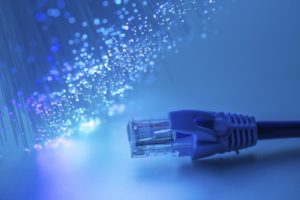
Learn how fiber cables function and how their unique abilities give you advantages.
Fiber optic cables are increasingly becoming the preferred network connection tool for businesses and homes across the world. But what makes fiber optic cables special, and different from traditional copper cables? The most significant feature of fiber optic cables is how they are made and how they function in a new way from copper cables. Their unique use of glass and light is what makes fiber optic cables beneficial to the high-speed Internet world of today. Read on to learn exactly how fiber optic cables function, and the advantages that their unique construction offers.
How Fiber Optic Cables Function
Fiber optic cables that help us in our daily computing duties consist of one or more strands of glass, each slightly thicker than a strand of human hair. The center of each strand is the core, which provides the pathway for traveling light. This core is then surrounded by a layer of glass called cladding, which reflects light inward to allow the light to pass through the bends of the cable and avoid signal loss.
The Two Types of Fiber Optic Cables
Precisely how fiber optic cables function depends on the type of cable that is being used. Single-mode fiber uses extremely thin glass strands as well as a laser to generate light, while multi-mode fiber optic cables use LEDs.
Single-mode fiber networks often use Wave Division Multiplexing techniques that increase the amount of data traffic that the strand can carry. WDM permits light at multiple wavelengths to be combined, or multiplexed, and later separated, or de-multiplexed, which effectively transmits multiple communication streams through a single pulse of light.
The Advantages of Fiber Optic Cables
Because of their construction, fiber optic cables offer several distinct advantages over long-distance copper cabling. These advantages include:
- The network bandwidth a fiber cable can carry can easily exceed that of a copper cable with a similar thickness. Fiber cables are often rated at 10 Gbps, 40 Gbps, and 100 Gbps.
- Signals on fiber can travel a longer distance without needing signal boosting. Signals attenuate over a distance of about 40 miles for single mode cables, and about 1,650 feet for multimode cables.
- A fiber optic cable is less vulnerable to interference, while a copper network cable requires shielding to protect it from electromagnetic interference. While this shielding can help, it is not sufficient to prevent interference in situations where many cables are strung together in proximity to one another. The physical properties of fiber optic cables make it easy to avoid most of these problems.
Knowing how fiber optic cables function can help us understand and appreciate the technological improvements that have made fiber optic cables the new standard for connectivity.
Get in Touch with FiberPlus
FiberPlus has been providing data communication solutions for 28 years in the Mid Atlantic Region for a number of different markets. What began as a cable installation company for Local Area Networks has grown into a leading provider of innovative technology solutions improving the way our customers communicate and keeping them secure. Our solutions now include:
- Structured Cabling (Fiber Optic, Copper and Coax for inside and outside plant networks)
- Electronic Security Systems (Access Control & CCTV Solutions)
- Wireless Access Point installations
- Public Safety DAS – Emergency Call Stations
- Audio/Video Services (Intercoms and Display Monitors)
- Support Services
- Specialty Systems
- Design/Build Services
FiberPlus promises the communities in which we serve that we will continue to expand and evolve as new technology is introduced within the telecommunications industry.
Have any questions? Interested in one of our services? Call FiberPlus today 800-394-3301, email us at info@fiberplusinc.com, or visit our contact page. Our offices are located in the Washington, DC metro area and Richmond, VA. In Pennsylvania, please call Pennsylvania Networks, Inc. at 814-259-3999.
Do you enjoy clicking “Like” and “Follow?” Be sure to click on our official Pinterest, Facebook, Twitter, and LinkedIn pages today!